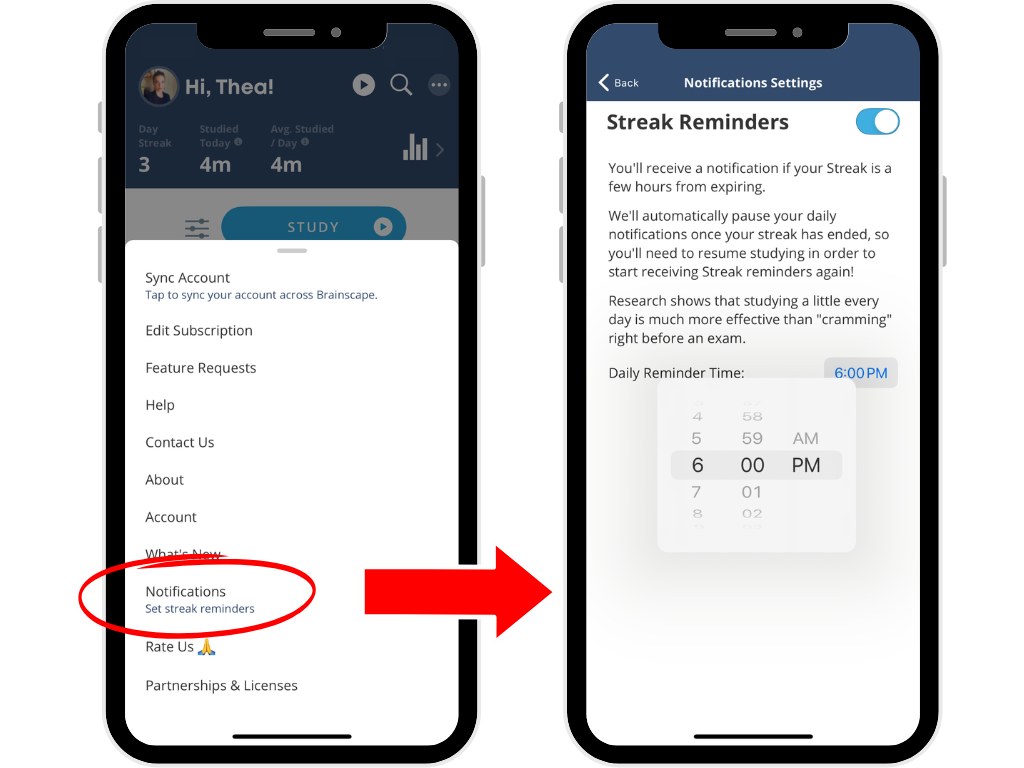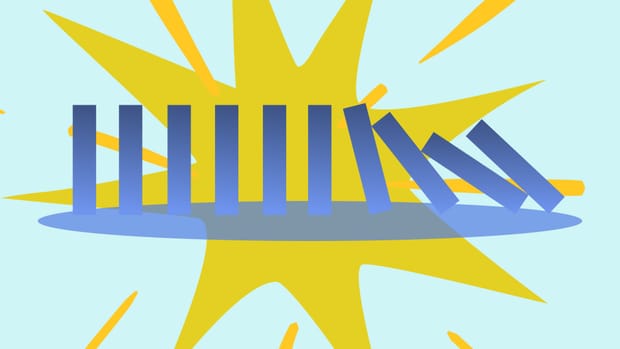“What the hell,” I said. “I may as well…
- Exercise later
- Have the whole bag of popcorn
- Drink another glass
- Study my ass off a few days before the exam
- Quit smoking next week
- Start on Monday
- Start on the first of the month
- Start next year…”
Sound familiar?
Confession. I have said all of these things at one point or another during my life.
You may have never heard of the “what the hell" effect (yes, that really is the scientific term for it) but I’d bet my bloomers that you, like me, have careened down its slippery slope many times throughout your life. You are human, I presume?
In this article, we explore the psychology behind the “What the Hell” Effect and the strategies you can use to break the cycle, regardless of what your personal or professional goals are.
Since you’re coming across this article in the Brainscape Academy—and Brainscape is a study/flashcard app—I’ll focus on how the “What the Hell” Effect can cause the catastrophic derailment of study plans and academic goals. But this advice can and should be applied to any habit you’re trying to make or break.
This is where you’ll learn to stop the spiral of negativity and transform regret into resolve.
What is the "What the Hell" Effect?
The "what the hell" effect is a real bastard of a spiral; one where a single, tiny failure unravels your intentions like a match to the Hindenburg. It's a psychological domino effect that sends your study goals, eating habits, exercise plan, financial aspirations, or career dreams to Hades.
The concept was first coined by psychologists Janet Polivy and C. Peter Herman. (See? It’s not just you. So many humans on planet Earth struggle with the "what the hell" effect that trained psychologists have named, shamed, and published a bunch of research papers on it.)
What are the Psychological Mechanisms Behind the What the Hell Effect?

The "what-the-hell effect" is a cognitive bias rooted in an all-or-nothing mindset. This causes a minor lapse to spiral into full abandonment of your goals, which then leads to indulgent behavior. Thus is the cycle: indulgence, regret, and more indulgence, fueled by guilt and shame.
The trigger? The momentary loss of self-control after breaking a self-imposed rule:
- Not pausing the Netflix show to resume your studies when you said you would. (You'll just pull an all-nighter before the exam, right?)
- Buying something you want—but don’t need—when you’re trying to save for a car or a down payment on a home.
- Putting off til tomorrow the assignment you planned to invest an hour into today. (Wait... let me guess: another all-nighter?)
- Tripping, falling, and accidentally eating three whole muffins when you’re on a slow-carb diet.
It’s human nature. When we experience failure, the psychological blow can make us abandon our goals. And once the limits are breached, feelings of hopelessness intensify, which then crumbles our willpower. After that, stress heightens the brain's fight-or-flight response, increasing vulnerability to temptation and weakening decision-making. Finally? Shame and guilt magnify future failures by eroding control and hope.
On the surface, you just ate three muffins. But beneath is a seething cauldron of guilt, shame, and hopelessness… and way too much insulin.
Told you the “what the hell” effect was a real bastard.
But enough of the problem. Let’s look at the solutions…
Strategies to Break the "What the Hell" Effect Cycle

It’s not about never falling; it’s about learning how to rise each time we do.
Tactic # 1: Set Realistic Goals
Setting realistic goals establishes guardrails against perceived failure. If your goals are unobtainable, chances are you will fail to achieve the difficult standards set, which leaves you vulnerable to the "what the hell" effect.
But if your goals are realistic (with a pinch of ambition) and if you proactively identify potential stumbling blocks and acknowledge vulnerabilities, you'll guard yourself against that sense of failure that sets in when things don't go as planned, allowing flexibility to adapt to life's curveballs.
(Check out 'How to create a study routine that maximizes productivity'. <– If your challenges are academic, this guide will help you plot out a realistic plan of action!)
Tactic # 2: Give Yourself a Break, Literally...
Build extra time, freedoms, or allowances into your strategy for occasional indulgences or time off:
- If you’re trying to lose weight, have one “cheat day” per week.
- If you’ve got exams looming, factor one rest day per week into your study schedule.
- If you're optimizing your savings and investments, set a small portion of your income aside for guilt-free spending.
This builds time, space, and freedom into your roadmap, which can absorb the impact of any missteps, leaving you feeling a lot less guilty if (or when) you trip up.
Tactic # 3: Set Goal Reminders
Our goals often become hazy as life unfolds, and using reminders becomes the tether that connects aspirations to action. Why are you doing this? What are you working towards? What’s your vision for your future self?
What's your WHY, damnit?
Orientate yourself in that vision and small missteps won’t feel like catastrophic failures.
Pro Tip: If your goal is a learning-oriented one, set study reminders in Brainscape so that you never miss a day and keep your study streak alive. Set it for the desired time of day and you’ll receive a gentle notification reminding you to keep your study streak alive!

Tactic # 4: Take a Beat Before Reacting
When setbacks arise, impulsive reactions tend to escalate the risk of plunging into the "what the hell" effect.
So you need to stop. Pause. Just for a second. Breathe.
Space is essential for processing your initial emotions, which are probably all chaotic, hot, and twisty. These are the feelings that trigger the unhealthy behaviors; that escalate an innocent mistake into a catastrophic derailment.
How can you enforce this pause when all you want to do is go all "Cookie Monster" on your kitchen pantry?
- Drink a glass of water
- Go for a walk around the block
- Take a hot bubble bath
- Have a power nap (45 minutes)
- Clip your toenails
- Meditate (if that's your thing)
What all of these things have in common is that they enforce time between the trigger and the reaction; AND they'll leave you better off than before. A glass of water will hydrate you and quell your hunger; a walk will improve circulation and release endorphins; clipping your toenails will improve your viability as an attractive mate (and increase the longevity of your socks). You get the idea.
(If your goals are academic, the linked guide will help you improve your study habits, so that they become more automatic and painless.)
Sure, you may very badly want to slam-dunk your goals into a garbage can. But that moment of relief—of release—is so very short-lived and punishes nobody but yourself. I can promise you that, most of the time, taking a pause halts the cycle, allowing you to pull back and make the smarter choice.
Researchers like Roy Baumeister and John Tierney reveal that dieters often find that success stumbles on rigid regimes; breaking a single rule leads to a cascade of compromised self-regulation. But by being adaptable and giving yourself time, you can reclaim control from the “what the hell” effect.
Tactic # 5: Silence the Inner Critic
Although perceived as a voice pushing one towards improvement, inner critics more often than not strangle motivation, seeding negative cycles. A study in Self and Identity discovered that self-compassionate individuals are likelier to pursue growth and mastery goals, embracing failure as a springboard, not a pitfall. Thus, shifting from self-criticism to self-kindness is not just therapeutic but a constructive skill that neutralizes guilt.
Saying it is easy enough. Doing it requires repetition. Every time that sh***y little voice manifests in your brain, make a conscious effort to acknowledge (not suppress) it and then speak aloud a different narrative: "Hi, little a**hole that lives in my head. Thanks for contributing your thoughts but today I choose to be kind to myself. I tried my best. It wasn't quite what I set out to achieve but I did get one little step closer." Or whatever.
Yes, this sounds totally woo-woo. But just like you can learn to play guitar by practicing every day, so too can you replace old, damaging mental narratives by repeating more positive scripts every time they happen. Trust me. It works.
You are the author. Write a better story.
Tactic # 6: Reframe Failures as Growth Opportunities
Failures are a natural part of any goal-oriented journey, but how we perceive and react to them makes all the difference. Imagine failures not as fatal endpoints but as essential learning detours on your path to success. Every "failure" teaches us something important about the skill we're trying to master, the goal we're trying to achieve, and our own strengths and weaknesses.
Leave the self-flagellation to 14th-century dungeons and erotic novels.
What’s important is NOT that you fell off the wagon… it’s that you can glean an insight from the experience: a better understanding of where your triggers and vulnerabilities lie, whether those are within your study strategy, diet approach, or emotional landscape.
You could be stronger for your failures, not weaker, if you leverage them as learning opportunities.
A Final Word on Conquering the "What the Hell" Effect

We've all experienced the "what the hell" effect—a psychological pothole that turns minor setbacks into full-blown failures. I opened this article with a laundry list of all of mine, many of which I’m sure you relate to. The good news is there are many strategies to combat the "what the hell" effect.
Start with realistic goals that challenge but don't overwhelm you. Set reminders to make those daily habits easy. Enforce a pause before you react when triggered. Silence the inner critic or, better yet, change the narrative completely. Understand that setbacks are not derailments but opportunities to learn more about where your vulnerabilities lie. Most of all, forgive yourself... because we're all human.
If you experiment with the tools discussed in this article, you will swiftly recover from any misstep and ensure that you continue chipping away at your goals.
I’m rootin’ for you!
References
Baumeister, R. F., Tierney, J., & O’Hare, D. P. (2011). Willpower: Rediscovering the greatest human strength. Simon & Schuster Audio.
Bobková, M., & Lovaš, L. (2021). The goal gradient hypothesis: Does performance increase with proximity to goal when autonomy is low? Current Psychology, 42(2), 1103–1111. https://doi.org/10.1007/s12144-021-01487-z
Goals and goal-setting. (2016). Personal Productivity, 33–46. https://doi.org/10.4324/9781315493299-10
Polivy, J., & Herman, C. P. (1985). Dieting and binging: A causal analysis. American Psychologist, 40(2), 193–201. https://doi.org/10.1037//0003-066x.40.2.193
Terry, M. L., & Leary, M. R. (2011). Self-compassion, self-regulation, and health. Self and Identity, 10(3), 352–362. https://doi.org/10.1080/15298868.2011.558404
